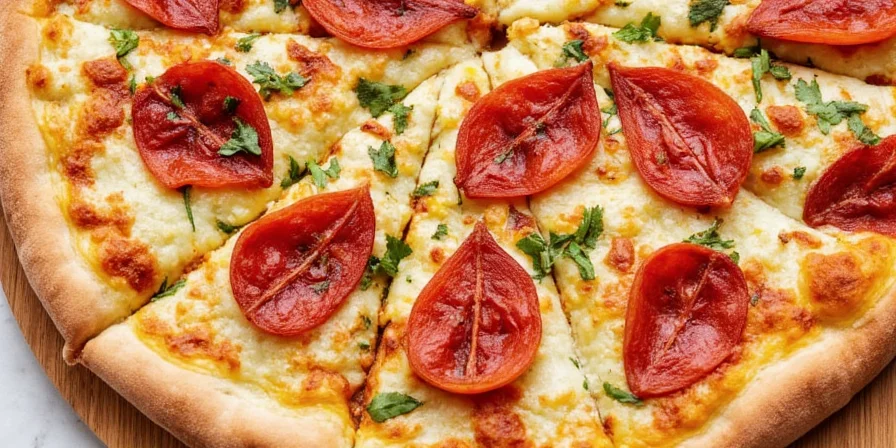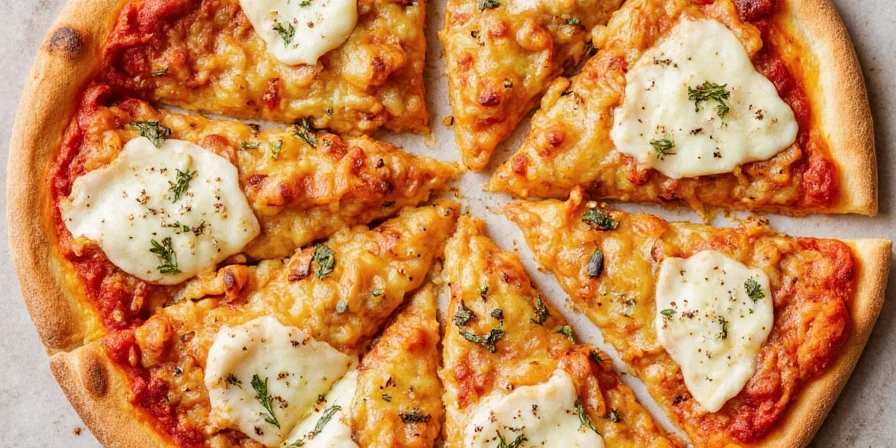Discover the 10 best spice combinations that transform ordinary pizza into extraordinary creations—backed by culinary science but designed for home cooks. Skip the chemistry lecture: use oregano + lemon zest for bright white pizzas, smoked paprika + garlic for meat lovers, and cumin + red pepper for fiesta flavor. These easy pairings work with store-bought crusts and deliver restaurant-quality results in 15 minutes or less.
Table of Contents
- Quick-Reference Spice Pairing Guide
- Oregano + Lemon Zest: The Sunshine Sprinkle
- Smoked Paprika + Garlic Powder: Smoky Depths
- Cumin + Crushed Red Pepper: The Fiesta Combo
- Coriander + Turmeric: Golden Fusion
- Basil + Fennel Seeds: Italian Dream Team
- Chili Flakes + Cilantro: Bold & Fresh
- Thyme + Parmesan Dust: Earthy Elegance
- Rosemary + Sea Salt: Crust Love
- Nutmeg + Mozzarella: Creamy Harmony
- Espresso Powder + Dark Chocolate: Dessert Surprise
- Spice Freshness Fixes That Actually Work
- 5-Minute Seasoning Hacks for Perfect Pizza
- Frequently Asked Questions

Quick-Reference Spice Pairing Guide
Use this cheat sheet for instant pizza upgrades—no culinary degree required. Just sprinkle these combinations on your next pie:
| For This Pizza Type | Best Spice Combo | When to Add |
|---|---|---|
| White pizza (ricotta/goat cheese) | Oregano + lemon zest | Zest after baking |
| Meat lovers | Smoked paprika + garlic powder | Mix into sauce |
| Tex-Mex pizza | Cumin + crushed red pepper | Before baking |
| Veggie pizza | Coriander + turmeric | Before baking |
| Margherita | Basil + fennel seeds | Fennel before, basil after |
1. Oregano + Lemon Zest: The Sunshine Sprinkle
- Why it works: Brightens creamy cheeses without overpowering them
- Best on: White pizzas with ricotta or goat cheese
- 30-second hack: Grate lemon zest directly over baked pizza using a microplane

2. Smoked Paprika + Garlic Powder: Smoky Depths
- Why it works: Adds grill-like flavor to indoor-baked pizzas
- Best on: Pepperoni, sausage, or roasted vegetable pizzas
- Pro move: Stir 1 tsp smoked paprika + 1/2 tsp garlic powder into tomato sauce before spreading
3. Cumin + Crushed Red Pepper: The Fiesta Combo
- Why it works: Creates restaurant-style depth in minutes
- Best on: Chicken jalapeño or black bean pizzas
- Time-saver: Keep pre-mixed 2:1 ratio (cumin:red pepper) in a spice shaker
4. Coriander + Turmeric: Golden Fusion
- Why it works: Makes veggie pizzas taste expensive
- Best on: Sweet potato, cauliflower, or butternut squash pizzas
- Warning: Use 1/4 tsp total per pizza—too much turns bitter

5. Basil + Fennel Seeds: Italian Dream Team
- Why it works: Authentic pizzeria flavor at home
- Best on: Margherita or sausage pizzas
- Cheat code: Crush fennel seeds with back of spoon before sprinkling
6. Chili Flakes + Cilantro: Bold & Fresh
- Why it works: Balances heat with freshness
- Best on: Shrimp or chicken curry pizzas
- Must-do: Add cilantro AFTER baking to keep it vibrant
7. Thyme + Parmesan Dust: Earthy Elegance
- Why it works: Turns basic cheese pizza into gourmet
- Best on: Mushroom or artichoke pizzas
- Waste-not: Make parmesan dust from cheese rinds in food processor
8. Rosemary + Sea Salt: Crust Love
- Why it works: Makes crust the star of the show
- Best on: Any pizza (especially thick crust)
- Visual trick: Press whole rosemary sprigs into dough before stretching

9. Nutmeg + Mozzarella: Creamy Harmony
- Why it works: Elevates bland mozzarella
- Best on: Four cheese or mushroom pizzas
- Better than pre-grated: Freshly grate nutmeg over pizza before serving
10. Espresso Powder + Dark Chocolate: Dessert Surprise
- Why it works: Makes sweet pizza taste expensive
- Best on: Fig, banana, or caramel apple pizzas
- Critical tip: Use 1/8 tsp espresso powder MAX per pizza

Spice Freshness Fixes That Actually Work
Most home cooks use stale spices without realizing it. Fix these common mistakes:
- Ground spices: Replace every 6 months (yes, even that "fresh" bottle from last year)
- Whole spices: Last 2+ years—keep cumin seeds instead of powder
- The sniff test: Rub between fingers—if you can't smell it strongly, it's dead
- Budget hack: Buy small quantities from bulk bins instead of big bottles
5-Minute Seasoning Hacks for Perfect Pizza
- The layering rule: Add dense spices (paprika, cumin) to sauce; delicate ones (basil, zest) after baking
- Measurement cheat: 1/4 tsp per standard pizza is perfect starting point
- The salt trick: Sprinkle sea salt after baking for flavor pop without bitterness
- Spice shaker: Mix your top 3 spices in a shaker for one-step seasoning
- Freezer storage: Keep extra spice blends in labeled bags for instant use
Frequently Asked Questions
What's the one spice every pizza needs?
Dried oregano is the universal pizza spice. Use 1/4 tsp per pizza mixed into sauce before baking. It's not just tradition—oregano's compounds activate perfectly at pizza baking temperatures, creating that familiar savory depth.
Can I use these with frozen pizza?
Yes! Add 3/4 of your spices during the last 2 minutes of baking. For best results: 1) Poke small holes in frozen crust with fork, 2) Add sauce and cheese as usual, 3) Sprinkle spices during final bake. This prevents sogginess while adding fresh flavor.
Which spices work best with store-bought sauce?
Smoked paprika (1/4 tsp) and garlic powder (1/8 tsp) are the top fixes for bland jarred sauce. Stir them in before spreading. If your sauce is too acidic, add a pinch of sugar along with the spices. These simple additions mimic hours of slow simmering.
How do I fix an over-spiced pizza?
Add neutralizing toppings immediately after baking: dollop of ricotta, drizzle of honey, or handful of fresh arugula. The dairy/fat counteracts spice heat, while sweet or bitter elements balance flavors. Next time, remember: you can always add more spice, but you can't remove it.
What's the most common pizza spice mistake?
Using pre-ground spices that have lost potency. The #1 issue we see: people sprinkle generous amounts of stale spices, creating bitter, unbalanced flavor. Solution: buy small quantities of whole spices, grind as needed, and replace every 6 months. Fresh spices need LESS quantity for MORE flavor.











 浙公网安备
33010002000092号
浙公网安备
33010002000092号 浙B2-20120091-4
浙B2-20120091-4